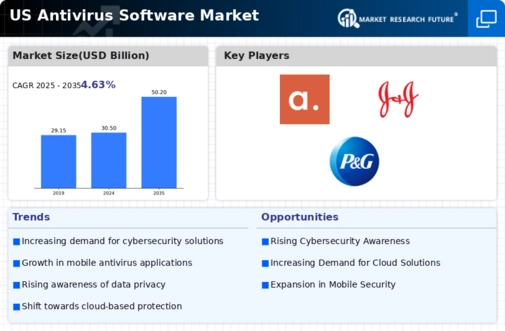Growing Cybersecurity Threats
The increasing frequency and sophistication of cyber threats is a primary driver for the antivirus software market. In recent years, the number of reported cyber incidents has surged, with a notable rise in ransomware attacks and data breaches. According to government data, the average cost of a data breach in the US reached approximately $4.24 million in 2023. This alarming trend compels both individuals and organizations to invest in robust antivirus solutions to safeguard sensitive information. The antivirus software market is thus experiencing heightened demand as consumers seek reliable protection against evolving threats. As cybercriminals continue to innovate, the need for advanced antivirus solutions that can adapt to new attack vectors becomes increasingly critical.
Increased Digital Transformation
The ongoing digital transformation across various sectors is significantly impacting the antivirus software market. As businesses increasingly adopt cloud services, remote work, and digital tools, the attack surface for cyber threats expands. A report indicates that 70% of organizations in the US have accelerated their digital transformation initiatives, leading to a greater reliance on technology. This shift necessitates robust antivirus solutions to protect against potential vulnerabilities. The antivirus software market is thus poised for growth as companies seek to secure their digital environments. The integration of antivirus software into digital strategies is becoming essential for maintaining operational integrity and safeguarding customer trust.
Rising Awareness of Cyber Hygiene
There is a growing awareness among consumers and businesses regarding the importance of cyber hygiene, which is driving the antivirus software market. Educational initiatives and high-profile cyber incidents have led to increased vigilance about online security practices. Surveys indicate that over 60% of US consumers now prioritize cybersecurity when choosing software solutions. This heightened awareness translates into a greater demand for antivirus software, as individuals and organizations recognize the need for proactive measures to protect their digital assets. The antivirus software market is thus benefiting from this cultural shift towards prioritizing cybersecurity, as users seek reliable solutions to enhance their online safety.
Regulatory Compliance Requirements
Regulatory frameworks in the US are becoming more stringent, necessitating compliance with data protection laws. The implementation of regulations such as the California Consumer Privacy Act (CCPA) and the Health Insurance Portability and Accountability Act (HIPAA) has heightened the need for effective cybersecurity measures. Organizations are required to implement antivirus software to protect sensitive data and avoid hefty fines. The antivirus software market is thus driven by the necessity for compliance, as failure to adhere to these regulations can result in penalties reaching millions of dollars. This regulatory landscape encourages businesses to invest in comprehensive antivirus solutions, ensuring they meet legal obligations while protecting their assets.
Technological Advancements in Antivirus Solutions
Technological advancements are continuously shaping the antivirus software market. Innovations such as machine learning, artificial intelligence, and behavioral analysis are enhancing the effectiveness of antivirus solutions. These technologies enable software to detect and respond to threats in real-time, significantly improving protection levels. The antivirus software market is witnessing a shift towards more sophisticated solutions that can adapt to emerging threats. As consumers become more tech-savvy, they are likely to seek out advanced antivirus products that offer comprehensive protection. This trend suggests that the market will continue to evolve, driven by the demand for cutting-edge technology in cybersecurity.

















Leave a Comment